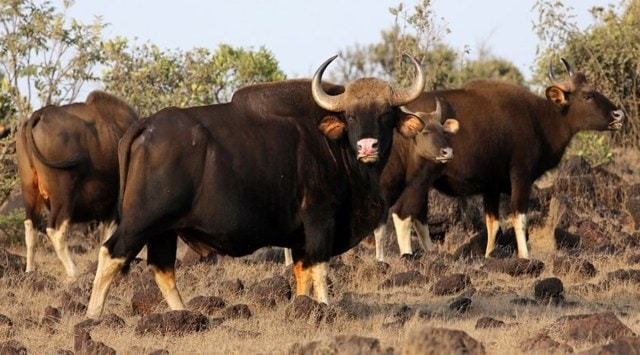- India
- International
Environment ministry declares 250 sq km area around Radhanagri wildlife sanctuary as eco-sensitive zone
Notified as a wildlife sanctuary in 1985, RWS is home to 264 bird species (migratory and resident), 47 species of mammals, 59 species of reptiles, 20 species of amphibians and 66 species of butterflies.
 The sanctuary is spread across 351.16 sq km known to serve as a corridor for tigers and elephants moving between three states -- Goa, Karnataka and Maharashtra. (radhanagariwildlife.com)
The sanctuary is spread across 351.16 sq km known to serve as a corridor for tigers and elephants moving between three states -- Goa, Karnataka and Maharashtra. (radhanagariwildlife.com)THE MINISTRY of Environment, Forest and Climate Change (MoEFCC) has notified 250.66 sq km around Maharashtra’s Radhanagri Wildlife Sanctuary (RWS), which is home to elephants and tigers, as an eco-sensitive zone (ESZ) The zone is meant to act as a buffer and a “shock absorber” for protected areas.
The demarcated area covers from 200 m to 6 km around the sanctuary. The MoEFCC published the final notification on October 15. New mining projects, stone quarrying, major hydroelectric projects, setting up of brick kilns and other red industries, which are highly polluting, are prohibited in the ESZ.
“All new and existing mining (minor and major minerals), stone quarrying and crushing units shall be prohibited with immediate effect except for meeting domestic needs of local residents, including digging up land for construction or repair work of houses within eco-sensitive zone,” read the notification. Organic farming, agriculture, small-scale industries and minor infrastructure work are permitted.
The sanctuary is spread across 351.16 sq km known to serve as a corridor for tigers and elephants moving between three states — Goa, Karnataka and Maharashtra.
“With the final notification, execution of development projects may be smooth outside the notified area, but also stringent measures in the notified area shall strengthen wildlife conservation measures undertaken by the government,” said V Clement Ben, chief conservator of forest (Kolhapur).

The ESZ is supposed to act as a transition zone from areas of high protection to less protection. The National Wildlife Action Plan 2002-2016 had identified them as “vital ecological corridor links” and stressed that they must be protected to prevent isolation of fragments of biodiversity.
Areas around Radhanagri Wildlife Sanctuary located towards the southern hills of the Sahyadri range of Western Ghats were being considered by the mining lobby. Activists said there were at least two bauxite ore mining projects underway in the area, while one was in the “exploratory” stage.
In October 2018, the Supreme Court ordered a mining company to stop operations at Durgmanwadi (within 10 km of RWS) as it was allegedly operating within the ESZ limits of the sanctuary without a wildlife clearance. On March 6, 2019, the mine’s environmental clearance was “kept in abeyance” by an order of the MoEFCC.
As many as 41 villages in Kolhapur and Sindhudurg districts are in the ESZ. “One should not view Radhanagri sanctuary in isolation, but as part of the Western Ghats, which needs conservation and protection. There is a misconception that once an area around the protected area, like a wildlife sanctuary, is declared an ESZ, people’s livelihoods are affected. Yes, there will be many living in the ESZ, who might say their livelihood was dependent on the mining industries, but there are other activities promoted in the area that can sustain them,” said Sunil Limaye, additional principal chief conservator of forests (wildlife).
While activities like mining and stone quarrying are prohibited, certain activities, which will be regulated and promoted, are listed in the final notification. Some include construction of hotels and resorts, albeit not within 1 km of the boundary of the protected area or up to the extent of ESZ, whichever is nearer. Agro-forestry, use of eco-friendly transport, cottage industries, and organic farming will also be promoted by the state government.
A zonal master plan will be prepared within two years from the date of publication for the protection of the ESZ. A monitoring committee headed by the Kolhapur district collector has also been formed.
Girish Punjabi, a wildlife biologist at Wildlife Conservation Trust (WCT), said, “Without notification of ESZ, mining activities and other construction activities go unchecked. With the demarcation, the uncertainty is gone for forest officials as well as industrialists. One of the best protections that come with the demarcation of ESZ is that no large infrastructure project can come up in the area or, at least, they have to go through a series of environment clearances.”
Notified as a wildlife sanctuary in 1985, RWS is home to 264 bird species (migratory and resident), 47 species of mammals, 59 species of reptiles, 20 species of amphibians and 66 species of butterflies.
In December 2018, the SC directed the MoEFCC to declare ESZs around 21 national parks and wildlife sanctuaries without buffer zones. In 2019, areas around Tungareshwar and Tansa wildlife sanctuaries in the state were also notified as ESZ.
Apr 24: Latest News
- 01
- 02
- 03
- 04
- 05






























